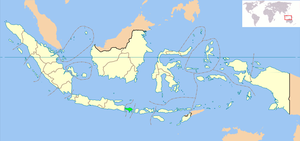
Bali is a tropical paradise in south-eastern Indonesia. It has fantastic beaches and resorts during the day, and lots pubs and bars to party well into the night.
Bali has been building its tourism industry for many years, so you will find that there are plenty of things to do for a family visit, even if you have a tight budget. There are also exciting things to do if you are travelling alone!
Bali 
Motto: Bali Dwipa Jaya
("Glorious Bali Island")
|
 |
| Capital | Denpasar |
| Governor | Dewa Made Beratha |
| Area | 5,632.86 km² (2,175 sq mi) |
| Population | 3,150,000 (2000) |
| Density | 559.2 /km² (1,448 /sq mi) |
| Ethnic groups | Balinese (89%), Javanese (7%), Baliaga (1%), Madurese (1%)[1] |
| Religion | Hindu (93.18%), Muslim (4.79%), Christian (1.38%), Buddhist (0.64%) |
| Languages | Indonesian (official), Balinese |
| Time zone | UTC+8 |
| Web site | www.baliprov.go.id |
Bali is Australia’s favourite holiday destination, so there are many Aussie families that have enjoyed the sights, culture and the hospitality of the Balinese people.

Bali is renowned its diverse and sophisticated art forms, such as painting, sculpture, woodcarving, handcrafts, and performing arts. Balinese percussion orchestra music, known as gamelan, is highly developed and varied. Balinese dances portray stories from Hindu epics such as the Ramayana but with heavy Balinese influence. Famous Balinese dances include pendet, legong, baris, topeng, barong, and kecak (the monkey dance).
The Hindu New Year, Nyepi, is celebrated in the spring by a day of silence. On this day everyone stays at home and tourists are encouraged to remain in their hotels. On the preceding day large, colorful sculptures of ogoh-ogoh monsters are paraded and finally burned in the evening to drive away evil spirits. Other festivals throughout the year are specified by the Balinese pawukon calendrical system.

National education programs, mass media and tourism continue to change Balinese culture. Immigration from other parts of Indonesia, especially Java, is changing the ethnic composition of Bali's population.
The Balinese eat with their right hand, as the left is impure, a common belief throughout Indonesia. The Balinese do not hand or receive things with their left hand and would not wave at anyone with their left hand.

 B
Bali consists of about three million people, nearly all of whom practice the Balinese Hindu religion, a heterogeneous amalgam in which gods and demigods are worshipped together with Buddhist heroes, with the spirits of ancestors and with indigenous deities associated with agriculture and with places considered sacred. Religion as it is practiced in Bali is a composite belief system that embraces not only theology, philosophy, and mythology, but ancestor worship, animism and magic. It is supposed to pervade every aspect of traditional life.

Bali is renowned its diverse and sophisticated art forms, such as painting, sculpture, woodcarving, handcrafts, and performing arts. Balinese percussion orchestra music, known as gamelan, is highly developed and varied. Balinese dances portray stories from Hindu epics such as the Ramayana but with heavy Balinese influence. Famous Balinese dances include pendet, legong, baris, topeng, barong, and kecak (the monkey dance).
Copyright : http://id.wikipedia.org/wiki/Bali , etc












